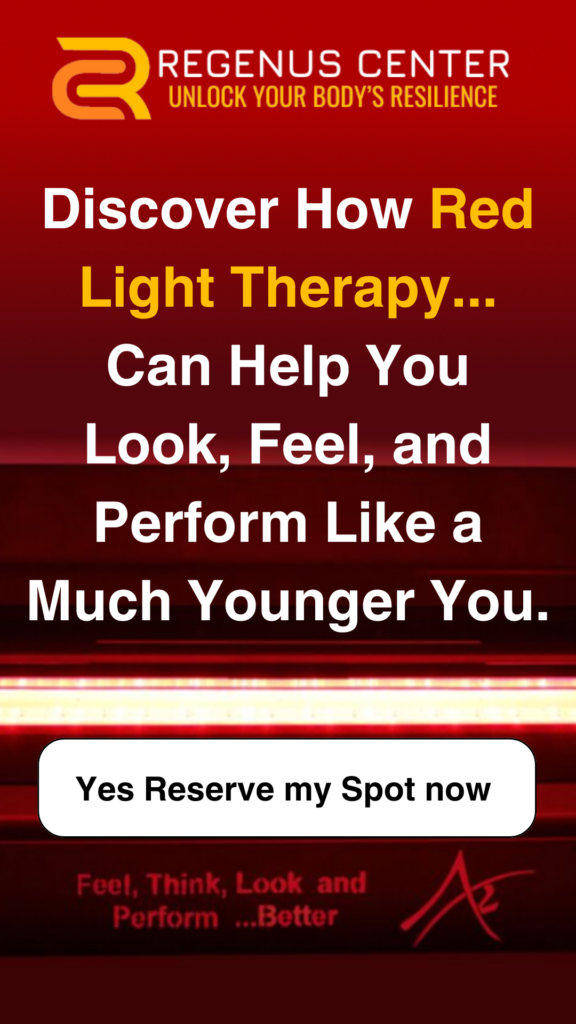Red light therapy (RLT), particularly when applied to the head in a process known as transcranial photobiomodulation (tPBM), shows promising potential in improving cognitive function. This non-invasive therapy uses specific wavelengths of red and near-infrared light to stimulate brain activity, enhance mitochondrial function, and promote neuroprotection, all of which can contribute to improved mental clarity, memory, attention, and overall cognitive performance. While more research is needed, emerging studies suggest that RLT could be a valuable tool in supporting cognitive health in various conditions, including age-related cognitive decline, brain injuries, and even mood disorders.
How Red Light Therapy May Improve Cognitive Function
- Enhances Mitochondrial Function and ATP Production
One of the key mechanisms of red light therapy is its ability to stimulate mitochondrial activity, increasing the production of ATP (adenosine triphosphate), the energy source for cells. Neurons, the cells in the brain responsible for transmitting signals, are highly energy-dependent, and improving mitochondrial function can boost their efficiency. By enhancing cellular energy, red light therapy can improve overall brain function, leading to better cognitive performance, memory, and focus.A study published in Frontiers in Neuroscience demonstrated that red light therapy improved mitochondrial function in neurons, leading to better cognitive outcomes in individuals with brain injuries and neurodegenerative conditions (Naeser et al., 2016).
- Increases Blood Flow and Oxygenation to the Brain
Red light therapy has been shown to improve blood circulation and oxygen delivery to tissues, including the brain. Increased blood flow brings more oxygen and nutrients to brain cells, supporting optimal brain function. Better oxygenation of the brain can enhance cognitive abilities such as attention, memory retention, and information processing, particularly in individuals experiencing cognitive decline due to aging or brain injury. - Promotes Neurogenesis and Brain Repair
Neurogenesis, the process of creating new neurons, is critical for maintaining cognitive health and brain plasticity. Red light therapy has been shown to promote neurogenesis by stimulating brain-derived neurotrophic factor (BDNF), a protein that supports the growth and survival of neurons. This can help repair damaged brain cells and support brain plasticity, which is essential for learning and memory.By encouraging neurogenesis and brain repair, red light therapy may improve cognitive function in individuals recovering from traumatic brain injuries, strokes, or age-related neurodegenerative diseases.
- Reduces Inflammation and Oxidative Stress in the Brain
Chronic inflammation and oxidative stress are significant contributors to cognitive decline and neurodegenerative diseases such as Alzheimer’s and Parkinson’s. Red light therapy’s anti-inflammatory properties can help reduce neuroinflammation, promoting a healthier environment for brain function. Additionally, RLT’s ability to reduce oxidative stress can protect brain cells from damage, preserving cognitive abilities as individuals age. - Improves Memory and Learning
By enhancing brain energy production, promoting neurogenesis, and improving brain connectivity, red light therapy may help improve memory formation and learning abilities. Research suggests that red light therapy can enhance both short-term and long-term memory by supporting brain regions such as the hippocampus, which is crucial for learning and memory retention. - May Help with Mood and Mental Clarity
Cognitive function is closely linked to mood and mental well-being. Red light therapy has been shown to improve mood, reduce symptoms of depression and anxiety, and enhance overall mental clarity. By regulating neurotransmitter activity and reducing stress hormones like cortisol, RLT may support a more balanced emotional state, which in turn can lead to clearer thinking and better cognitive performance.
Scientific Evidence Supporting Red Light Therapy for Cognitive Function
Several studies have explored the effects of red light therapy on cognitive function, with promising results:
- Traumatic Brain Injury (TBI): A study published in Frontiers in Neuroscience found that transcranial photobiomodulation improved cognitive function, mood, and sleep in individuals with traumatic brain injuries. Participants experienced improvements in attention, memory, and executive function after several weeks of RLT treatment (Naeser et al., 2016).
- Alzheimer’s Disease and Dementia: In a pilot study, red light therapy was shown to improve cognitive function in individuals with dementia and Alzheimer’s disease. Participants demonstrated improvements in memory, attention, and information processing speed after consistent use of red light therapy (Saltmarche et al., 2017).
- Cognitive Decline and Aging: A study published in Photobiomodulation, Photomedicine, and Laser Surgery found that transcranial red light therapy improved cognitive performance in older adults experiencing age-related cognitive decline. Improvements in memory, attention, and mental clarity were observed after regular sessions of RLT (Berman et al., 2017).
How to Use Red Light Therapy for Cognitive Function
- Transcranial Photobiomodulation (tPBM)
Transcranial photobiomodulation involves applying red or near-infrared light to the scalp, allowing the light to penetrate through the skull and into the brain tissue. This technique targets areas of the brain associated with cognitive function, such as the prefrontal cortex and hippocampus. tPBM can be administered using specialized devices designed for brain treatment, including light helmets or bands that cover the head. - Wavelengths for Cognitive Enhancement
The optimal wavelengths for red light therapy targeting cognitive function typically range between 630 nm and 850 nm. These wavelengths can penetrate the scalp and reach the brain tissues to promote neurogenesis, reduce inflammation, and enhance mitochondrial function. Near-infrared light (around 810 nm) is particularly effective for penetrating deeper into brain tissues. - Treatment Frequency and Duration
Consistent use of red light therapy is key to achieving cognitive benefits. Most studies recommend treatments 3-5 times per week, with sessions lasting 10-20 minutes. Long-term use, over the course of several weeks or months, is necessary to see significant improvements in cognitive function. - Professional vs. At-Home Use
Red light therapy for cognitive function can be administered by healthcare professionals in clinical settings or through FDA-approved at-home devices designed for transcranial photobiomodulation. At-home devices like light helmets and headbands are available for individuals seeking regular, convenient treatments for cognitive enhancement.
Safety Considerations
- Consult with a Healthcare Provider: While red light therapy is generally safe, individuals with certain conditions, such as epilepsy or photosensitivity, should consult with a healthcare provider before using transcranial photobiomodulation. A healthcare professional can help determine if RLT is appropriate for your specific cognitive concerns.
- Avoid Overexposure: Follow recommended treatment times and frequencies to avoid overexposure to red light, which can lead to mild skin irritation or discomfort. Typical sessions last between 10-20 minutes.
Conclusion
Red light therapy holds great potential for improving cognitive function by enhancing mitochondrial activity, increasing blood flow, promoting neurogenesis, and reducing inflammation in the brain. Whether used for age-related cognitive decline, brain injuries, or general cognitive enhancement, transcranial photobiomodulation may offer significant benefits for mental clarity, memory, learning, and mood. Consistent use of red light therapy, combined with other cognitive health strategies, can support brain health and improve overall cognitive performance.
Keywords: red light therapy for cognitive function, transcranial photobiomodulation, brain health, memory improvement, RLT for mental clarity, brain injury recovery.
References:
- Naeser, M. A., et al. (2016). “Improvement in cognitive function, mood, and sleep using red light therapy for brain injuries.” Frontiers in Neuroscience.
- Saltmarche, A. E., et al. (2017). “Effects of transcranial red light therapy on cognitive function in Alzheimer’s disease and dementia.” Photobiomodulation, Photomedicine, and Laser Surgery.
- Berman, M. H., et al. (2017). “Transcranial photobiomodulation for improving cognitive performance in older adults.” Photobiomodulation, Photomedicine, and Laser Surgery.



